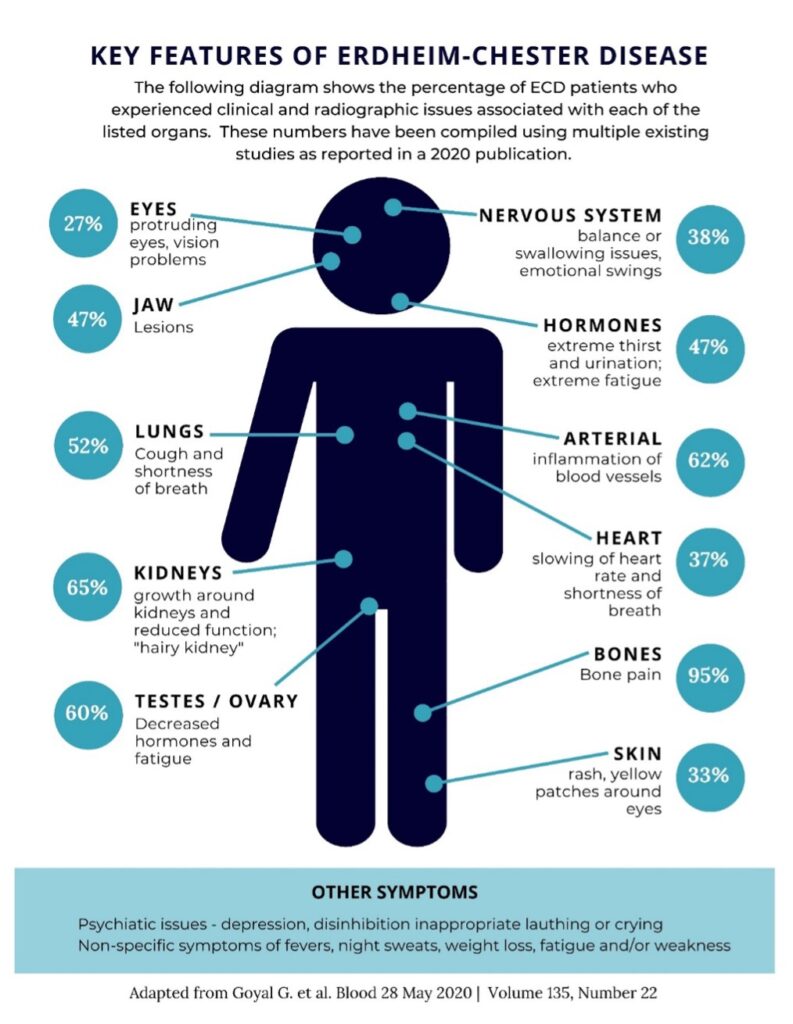The symptoms of ECD depend on which organ(s) are involved, which varies with each patient. For this reason, the symptoms of ECD will vary with each patient. Only a healthcare provider can diagnose ECD, but some of the more common symptoms might include one or more of the following:
- Bone Pain. The most common symptom reported is bone pain in the long bones of the legs on both sides (bilateral). Leg pain occurs most often in the knees, shins, and ankles. Arm pain can occur rarely and is most often in the upper arms. More than 90% of patients with ECD share this symptom, but it is important to note that some patients never have bone pain symptoms.
- General malaise and other non-specific symptoms. Many ECD patients report fatigue, weakness, weight loss, fever, night sweats, muscle and joint aches, and/or feelings of discomfort. Some patients report flu-like symptoms that linger or continue to return.
- Neurological Symptoms. When ECD impacts the brain, balance issues may occur, making walking difficult, with some patients reporting falls. Other symptoms of neurological involvement include slurred speech, swallowing problems, memory concerns, emotional and/or behavior changes, and/or other changes in usual disposition. Involuntary, rapid eye movements have also been seen as a neurological symptom.
- Excessive thirst and urination (Arginine Vasopressin Deficiency, also called Diabetes Insipidus or DI). This is sometimes one of the first symptoms ECD patients encounter. Once DI is identified, it can be easily treated with a medicine known as desmopressin, which can be given via an injection (shot), a pill, or a nasal spray.
- Hormonal changes. ECD patients sometimes report changes in sexual libido or orgasm, as well as irregularities in menstrual periods for females. These symptoms occur as the result of disease involvement in the pituitary gland. Less often, secretions from the nipples (galactorrhea) in the absence of pregnancy or childbirth can also occur.
- Kidney issues. ECD can affect the retroperitoneum (tissue surrounding kidneys and large blood vessels like the aorta) and kidneys. Lower back, flank or abdominal pain can be associated with kidney issues. Imaging tests often report a ‘hairy-like kidney, or a doctor might discover reduced kidney function.
- Bulging of the eye (exophthalmos) and/or vision difficulties. Vision-related issues may include bilateral fluttering in the peripheral vision, double vision, reduced vision, or other vision disturbances.
- Sores or bumps under the skin (xanthomas) or rash around the eyes (xanthelasma). Yellow growths on or near the eyelids can be a symptom of ECD.
- Shortness of breath (dyspnea) and/or cough. ECD can affect the heart and/or lungs. Cardiovascular involvement can include fluid collecting around the heart, infiltration within the heart muscle itself, or inflammation of blood vessels. Progressive scarring and thickening of the lungs occur with lung involvement. These issues make it more difficult for blood to be properly pumped through the body. The main symptoms are chest pain or shortness of breath.
- Chronic pain, fatigue, depressed mood, anxiety. A large proportion of patients with ECD report chronic generalized (all over the body) pain and fatigue. These symptoms are further worsened by concomitant problems with mood, resulting in depression and anxiety. Pain and fatigue can persist despite ECD being in remission.
A single patient may have a different combination of these symptoms, along with others. Few patients have all the above symptoms. This is partly what makes ECD difficult to diagnose. An ECD diagnosis requires a review of symptoms in conjunction with imaging (PET-CT and MRI if available) and biopsies performed by a knowledgeable medical team.
Anyone who suspects they may have ECD should seek the help of a knowledgeable healthcare provider. Earlier diagnosis will potentially give patients the best chance for a successful treatment plan.
In late 2018, the ECD Patient Registry resulted in the following symptom assessment article. Findings include a percentage table of patient-reported symptoms. See A scale for patient-reported symptom assessment for patients with Erdheim-Chester disease to learn more.
Last updated: October 31, 2024









